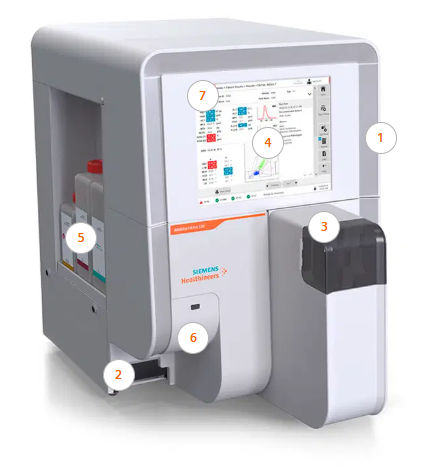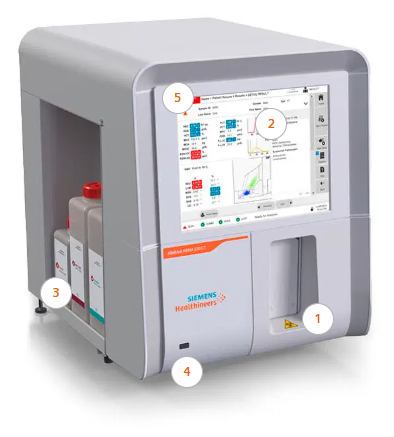The Atellica HEMA 520 and 530 Analyzers combine established performance in a dependable, compact bench-top instrument that boasts great productivity and one of the lowest footprints on the market.
The Atellica HEMA 520 and 530 Analyzers are also smart and powerful, producing high-quality data while being adaptable to varied testing situations. Whether running a small, specialized lab or part of a large-volume operation, the Atellica HEMA 520 and 530 Analyzers provide the dependability and efficiency users want.
Features and benefits
Advanced capabilities for comprehensive hematology testing
The Atellica HEMA 520 OT, 520 CT, and 530 Analyzers are low-volume hematology analyzers that provide:
Optimized reagent management
Optimize inventory management by using only a few reagents for testing (a maximum of two) - less waste, less packing, and less toxicity. Secured reagent management using a unique reagent code to ensure traceability, audit trails, and results quality.
Intuitive user interface
The intuitive touchscreen interface, which includes color-coded warnings and flags, makes it easier for less experienced employees to use, minimizes unnecessary clicks with smart quick-click operation, and enables employees to take appropriate action and handle exceptions quickly.
Robust quality management
Implementing strong quality control processes and procedures allows your lab to ensure accurate and reliable results. The system offers enhanced visual monitoring through X-bar, Levey-Jennings, and Radar charts for comprehensive quality management.
Intuitive user interface
The intuitive touchscreen interface simplifies operation, even for less experienced staff. Color-coded alerts and flags facilitate easy navigation, while smart quick-click operations eliminate unnecessary steps. This design empowers your team to take appropriate action and manage exceptions more quickly.
Robust quality management
Labs can get accurate and trustworthy findings by establishing rigorous quality control systems and procedures. Improved visual monitoring using X-bar, Levey-Jennings, and Radar charts.
Low sample volume requirements
Provides patients with a comprehensive clinical picture using only 20 μL of blood. Also decreases difficulties.
Take a tour of the low-volume hematology systems and see which is right for your lab
Atellica HEMA 530 Analyzer

Image Credit: Siemens Healthineers
- 1
- Autoloader with STAT tube sampling
- Rack mode with 40 tube capacity (4 racks × 10 tubes)
- Continuous loading
- Automated tube mixing by rotation, 90° rotation for 30-40 seconds
- 2
- 3
- STAT Tube sampling: closed (cap piercing) and open tube options
- 4
- 5
- Reagent compartment
- Insert/remove reagent bottles
- 6
- USB Port
- Upload assigned values for calibrator and controls
- Download patient and QC files results
- 7
- System status indicator
- QUAL: invalid, failed control, XB
- COMM: LIS or printer errors
- REAG: empty or expired reagent, insufficient volume of reagent to perform analysis
- SYST: failed cycle, mechanical problem
- Green: Analyzer ready for analysis, no unresolved alarms
- Red: Flashes, turns red when alarm appears, stays red until resolved
Atellica HEMA 520 CT Analyzer

Image Credit: Siemens Healthineers
- 1
- Closed tube sampling
- Closed (cap piercing) and open tube sampling options
- 2
- 3
- Reagent compartment
- Insert/remove reagent bottles
- 4
- USB Port
- Upload assigned values for calibrator and controls
- Download patient and QC files results
- 5
- System status indicator
- QUAL: invalid, failed control, XB
- COMM: LIS or printer errors
- REAG: empty or expired reagent, insufficient volume of reagent to perform analysis
- SYST: failed cycle, mechanical problem
- Green: Analyzer ready for analysis, no unresolved alarms
- Red: Flashes, turns red when alarm appears, stays red until resolved
Atellica HEMA 520 OT Analyzer

Image Credit: Siemens Healthineers
- 1
- 2
- 3
- Reagent compartment
- Insert/remove reagent bottles
- 4
- USB Port
- Upload assigned values for calibrator and controls
- Download patient and QC files results
- 5
- System status indicator
- QUAL: invalid, failed control, XB
- COMM: LIS or printer errors
- REAG: empty or expired reagent, insufficient volume of reagent to perform analysis
- SYST: failed cycle, mechanical problem
- Green: Analyzer ready for analysis, no unresolved alarms
- Red: Flashes, turns red when alarm appears, stays red until resolved
Technical specifications
Learn about the essential specs and differences of the Atellica HEMA 520 OT, 520 CT, and 530 Analyzers.
Dimensions. Source: Siemens Healthineers
| . |
. |
| Atellica HEMA 520 OT and 520 CT Analyzers |
39.7 x 47.7 x 48.3 cm (15.63 x 18.78 x 19.02 in.)
(width x depth x height) |
| Atellica HEMA 530 Analyzer |
53 x 66.8 x 62.1 cm (20.87 x 26.3 x 24.45 in.)
(width x depth x height) |
Test selectivity/Throughput. Source: Siemens Healthineers
| . |
. |
| CBC/DIFF |
60 samples/hour |
Sample modes/Volume. Source: Siemens Healthineers
| . |
. |
| Atellica HEMA 520 OT and 520 CT Analyzers |
20 µL |
| Atellica HEMA 530 Analyzer |
Rack Mode
(continuous loading): 20 µL
STAT Mode
(closed or open tube): 20 µL |
Performance specifications. Source: Siemens Healthineers
| . |
. |
| Linear Ranges |
WBC: 0.2–300 x 103/mm3
RBC: 0.2–8 x 106/mm3
PLT: HGB >1.5 10–2500 x 103/mm3
HGB <1.5 10–4000 x 103/mm3
HGB: 1–24 g/dL
HCT: 2–67% |
Parameters. Source: Siemens Healthineers
| . |
. |
| CBC Results |
WBC, RBC, HGB, HCT, MCV, MCH, MCHC, RDW-CV,
RDW-SD, MIC%,* MAC%,* PLT, MPV, PCT,* PDW,*
P-LCC, P-LCR |
| Differential Results |
LYM#, LYM%, MON#, MON%, NEU#, NEU%, EOS#,
EOS%, BAS#, BAS%, ALY#,* ALY%,* LIC#,*
LIC%,* IML#,* IML%,* IMM#,* IMM%,* IMG#, IMG% |
Precision. Source: Siemens Healthineers
| . |
Low Level |
Normal Level |
High Level |
| Parameter |
CV Limits (%) |
Range |
CV Limits (%) |
Range |
CV Limits (%) |
Range |
| WBC |
10 |
0.23–4 x 103/mm3 |
3 |
4–10 x
103/mm3 |
3 |
10–300 x
103/mm3 |
| RBC |
3 |
0.5–3.6 x 106/mm3 |
2 |
3.6–6.2 x 106/mm3 |
2 |
6.2–8 x 106/mm3 |
| HGB |
1.5 |
5–12 g/dL |
1.5 |
12–18 g/dL |
1.5 |
6.2–8 x 106/mm3 |
| MCV |
1.5 |
<80 fL |
1.5 |
80–100 fL |
1.5 |
>100–max. fL |
| PLT |
10 |
10–180 x 103/mm3 |
5 |
180–500 x 103/mm3 |
5 |
500–1000 x 103/mm3 |